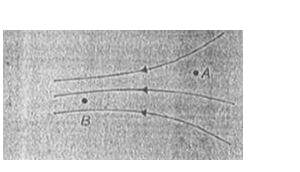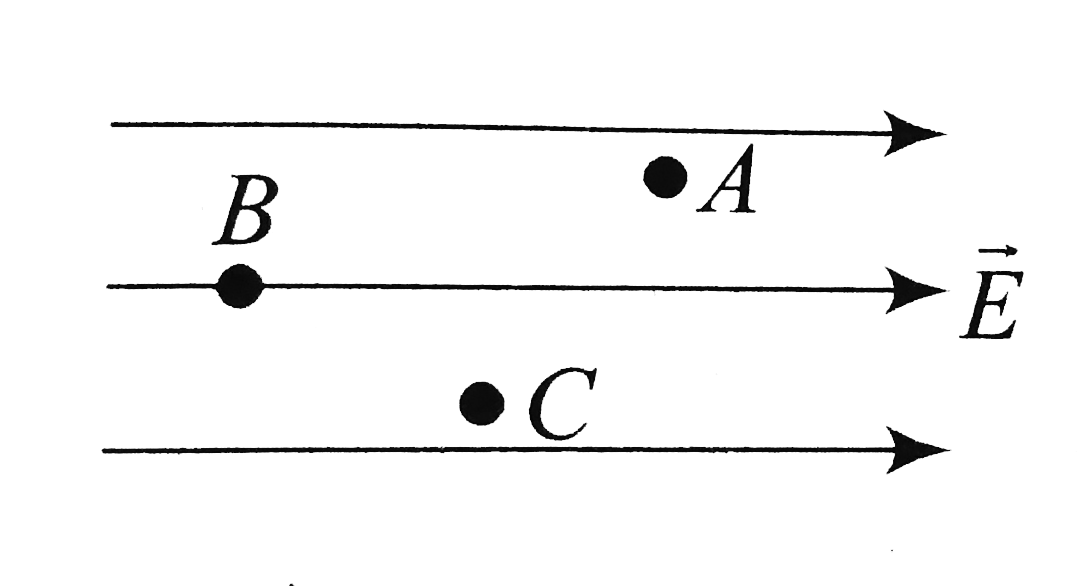The work done in carrying a charge of 5μC form a point A to a point B in an electric field is 10mJ. The potential difference (VB−VA) is then
+2kV
−2kV
+200kV
−200kV
The correct Answer is:A
To find the potential difference VB−VA when carrying a charge from point A to point B in an electric field, we can use the relationship between work done, charge, and potential difference.
1. Identify the given values:
- Charge Q=5μC=5×10−6C
- Work done W=10mJ=10×10−3J
2. Use the formula for work done in terms of potential difference:
The work done W in moving a charge Q through a potential difference VB−VA is given by:
W=Q⋅(VB−VA)
3. Rearrange the formula to find the potential difference:
VB−VA=WQ
4. Substitute the known values into the equation:
VB−VA=10×10−3J5×10−6C
5. Calculate the potential difference:
VB−VA=10×10−35×10−6=105×103=2×103V
VB−VA=2000V=2kV
Final Answer:
The potential difference VB−VA is 2kV.
---
- Charge Q=5μC=5×10−6C
- Work done W=10mJ=10×10−3J
The work done W in moving a charge Q through a potential difference VB−VA is given by:
W=Q⋅(VB−VA)
VB−VA=WQ
VB−VA=10×10−3J5×10−6C
VB−VA=10×10−35×10−6=105×103=2×103V
VB−VA=2000V=2kV
The potential difference VB−VA is 2kV.
Topper's Solved these Questions
- ELECTROSTATIC POTENTIAL AND CAPACITORSBOOK - DC PANDEY ENGLISHCHAPTER - ELECTROSTATIC POTENTIAL AND CAPACITORSEXERCISE - (B) Chapter exercises
17 Videos
- ELECTROSTATIC POTENTIAL AND CAPACITORSBOOK - DC PANDEY ENGLISHCHAPTER - ELECTROSTATIC POTENTIAL AND CAPACITORSEXERCISE - (C) Chapter exercises
50 Videos
- ELECTROSTATIC POTENTIAL AND CAPACITORSBOOK - DC PANDEY ENGLISHCHAPTER - ELECTROSTATIC POTENTIAL AND CAPACITORSEXERCISE - Check point 2.5
20 Videos
- ELECTROMAGNETIC WAVESBOOK - DC PANDEY ENGLISHCHAPTER - ELECTROMAGNETIC WAVESEXERCISE - Sec C
22 Videos
- ELECTROSTATICSBOOK - DC PANDEY ENGLISHCHAPTER - ELECTROSTATICSEXERCISE - Medical entrances gallery
37 Videos
Similar Questions
In figure two points A and B are located in a region of electric field . The potential difference VB−VA is

View SolutionThe work done in carrying a point charge form one point to another in an electrostatic field depends on the path along which the point charge is carried.
View SolutionA,B and C are three points in a unifrom electric field. The electric potential is

View SolutionWhen a 2μC charge is carried from point A to point B, the amount of work done by the electric field is 50μJ. What is the potential difference and which point is at a higher potential ?
View SolutionHow much work will be done in bringing a charge of 400μC from infinity to some point P in the region of electric field ? Given that the electric potential at point P is 20 V ?
View SolutionA point charge is taken from a point A to a pint B in an electric field. Does the work done by the electric field depend on the path of the charge ?
View SolutionIn moving a unit positively charged body from point A to point B external work donw is 40 J and body acquires a kinetic energy of 20 J . The potential differnece VB−VA, is
View SolutionHow much work is done in moving a charge of 2C across two points having a potential difference of 12V ?
View SolutionFind the work done by some external force in moving a charge q=2μC from infinity to a point where electric potential is 104 V.
View SolutionFind the work done by some external force in moving a charge q=4μC from infinity to a point, where electric potential is 104V
View Solution
